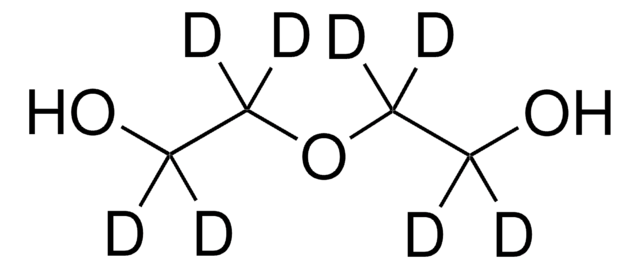Products may be shipped at a different temperature than the recommended long-term storage temperature. If the product quality is sensitive to short-term exposure to conditions other than the recommended long-term storage, it will be shipped on wet or dry-ice. If the product quality is NOT affected by short-term exposure to conditions other than the recommended long-term storage, it will be shipped at ambient temperature. As shipping routes are configured for minimum transit times, shipping at ambient temperature helps control shipping costs for our customers. For more information, please refer to the Storage and Transport Conditions document: https://www.sigmaaldrich.com/deepweb/assets/sigmaaldrich/marketing/global/documents/316/622/storage-transport-conditions-mk.pdf
93171
Diethylene glycol
BioUltra, ≥99.0% (GC)
Synonyme(s) :
2,2′-oxydiéthanol, 2-hydroxyéthyl éther
Sélectionner une taille de conditionnement
Sélectionner une taille de conditionnement
About This Item
Produits recommandés
Densité de vapeur
2.14 (vs air)
Pression de vapeur
0.01 mmHg ( 20 °C)
Description
non-ionic
Gamme de produits
BioUltra
Essai
≥99.0% (GC)
Forme
liquid
viscous liquid
Température d'inflammation spontanée
442 °F
Limite d'explosivité
2-12.3 %
Impuretés
insoluble matter, passes filter test
≤30 mg/kg peroxides (as H2O2)
Indice de réfraction
n20/D 1.447 (lit.)
n20/D 1.447
pH
5.5-7.0 (25 °C, 50 mg/mL in H2O)
pb
245 °C (lit.)
Pf
−10 °C (lit.)
Solubilité
H2O: 50 mg/mL at 20 °C, clear, colorless
Densité
1.118 g/mL at 25 °C (lit.)
Traces d'anions
chloride (Cl-): ≤50 mg/kg
sulfate (SO42-): ≤50 mg/kg
Traces de cations
Al: ≤10 mg/kg
As: ≤0.1 mg/kg
Ba: ≤5 mg/kg
Bi: ≤5 mg/kg
Ca: ≤10 mg/kg
Cd: ≤5 mg/kg
Co: ≤5 mg/kg
Cr: ≤5 mg/kg
Cu: ≤5 mg/kg
Fe: ≤5 mg/kg
K: ≤200 mg/kg
Li: ≤5 mg/kg
Mg: ≤5 mg/kg
Mn: ≤5 mg/kg
Mo: ≤5 mg/kg
Na: ≤200 mg/kg
Ni: ≤5 mg/kg
Pb: ≤5 mg/kg
Sr: ≤5 mg/kg
Zn: ≤5 mg/kg
Chaîne SMILES
OCCOCCO
λ
50 mg/mL in H2O
Absorption UV
λ: 260 nm Amax: ≤0.060
λ: 280 nm Amax: ≤0.030
InChI
1S/C4H10O3/c5-1-3-7-4-2-6/h5-6H,1-4H2
Clé InChI
MTHSVFCYNBDYFN-UHFFFAOYSA-N
Vous recherchez des produits similaires ? Visite Guide de comparaison des produits
Application
Mention d'avertissement
Warning
Mentions de danger
Conseils de prudence
Classification des risques
Acute Tox. 4 Oral
Code de la classe de stockage
10 - Combustible liquids
Classe de danger pour l'eau (WGK)
WGK 1
Point d'éclair (°F)
280.4 °F - closed cup
Point d'éclair (°C)
138 °C - closed cup
Équipement de protection individuelle
Eyeshields, Faceshields, Gloves, type ABEK (EN14387) respirator filter
Faites votre choix parmi les versions les plus récentes :
Certificats d'analyse (COA)
Vous ne trouvez pas la bonne version ?
Si vous avez besoin d'une version particulière, vous pouvez rechercher un certificat spécifique par le numéro de lot.
Déjà en possession de ce produit ?
Retrouvez la documentation relative aux produits que vous avez récemment achetés dans la Bibliothèque de documents.
Les clients ont également consulté
-
How is shipping temperature determined? And how is it related to the product storage temperature?
1 réponse-
Utile ?
-
-
How can I determine the shelf life / expiration / retest date of this product?
1 réponse-
If this product has an expiration or retest date, it will be shown on the Certificate of Analysis (COA, CofA). If there is no retest or expiration date listed on the product's COA, we do not have suitable stability data to determine a shelf life. For these products, the only date on the COA will be the release date; a retest, expiration, or use-by-date will not be displayed.
For all products, we recommend handling per defined conditions as printed in our product literature and website product descriptions. We recommend that products should be routinely inspected by customers to ensure they perform as expected.
For products without retest or expiration dates, our standard warranty of 1 year from the date of shipment is applicable.
For more information, please refer to the Product Dating Information document: https://www.sigmaaldrich.com/deepweb/assets/sigmaaldrich/marketing/global/documents/449/386/product-dating-information-mk.pdfUtile ?
-
Filtres actifs
Notre équipe de scientifiques dispose d'une expérience dans tous les secteurs de la recherche, notamment en sciences de la vie, science des matériaux, synthèse chimique, chromatographie, analyse et dans de nombreux autres domaines..
Contacter notre Service technique








